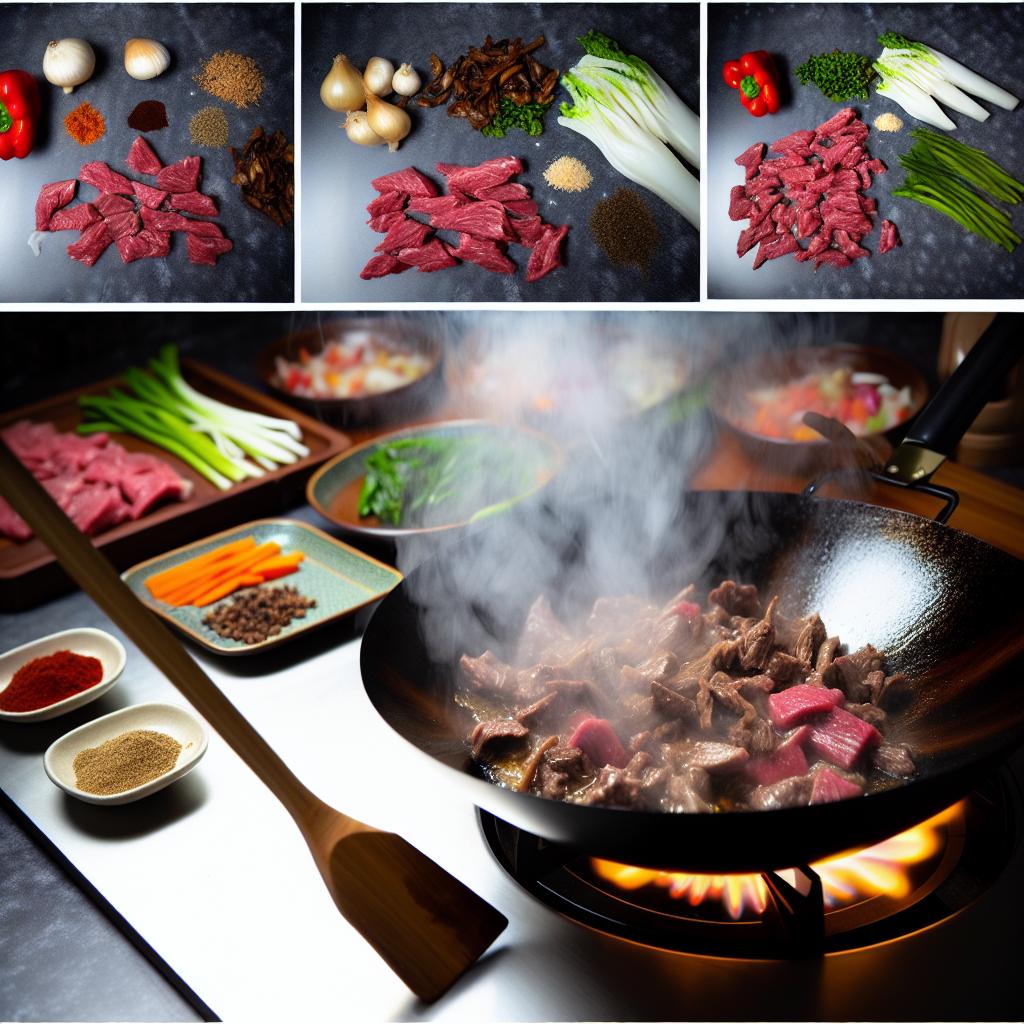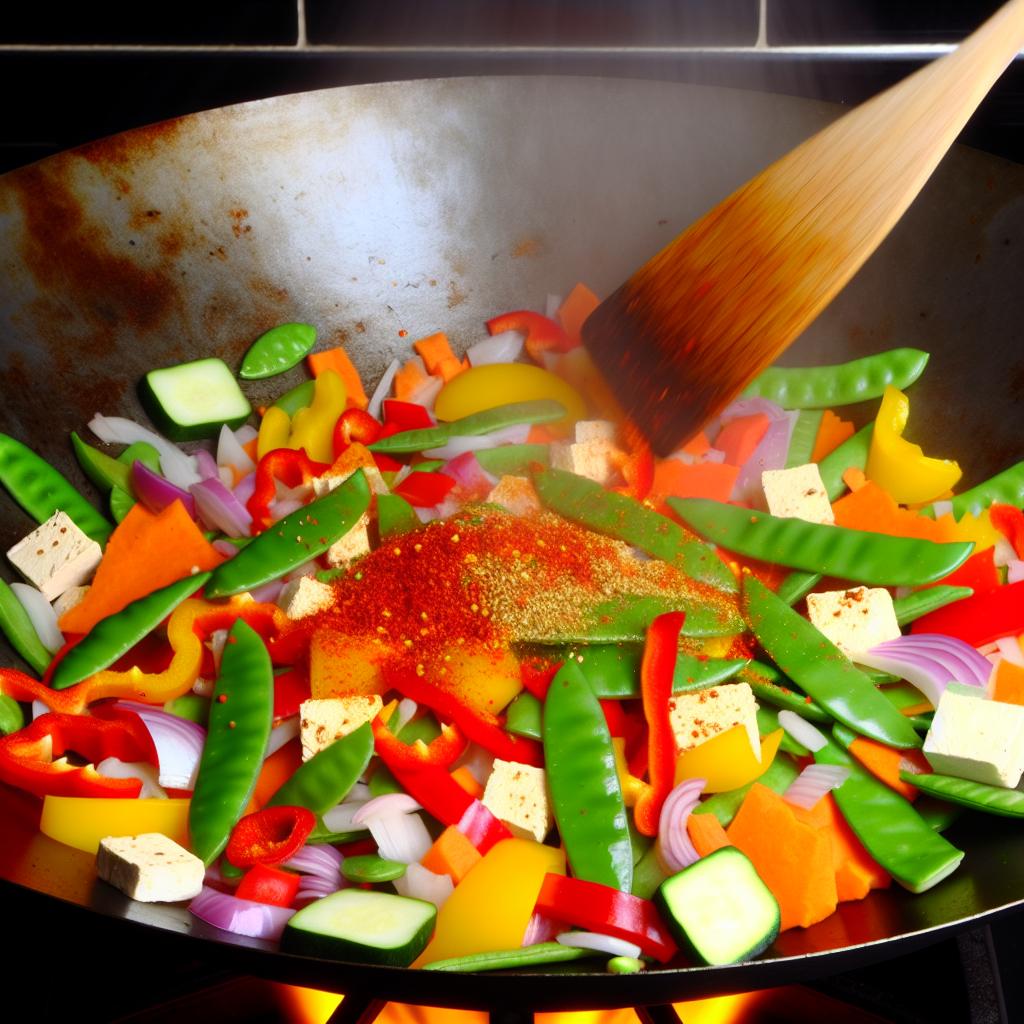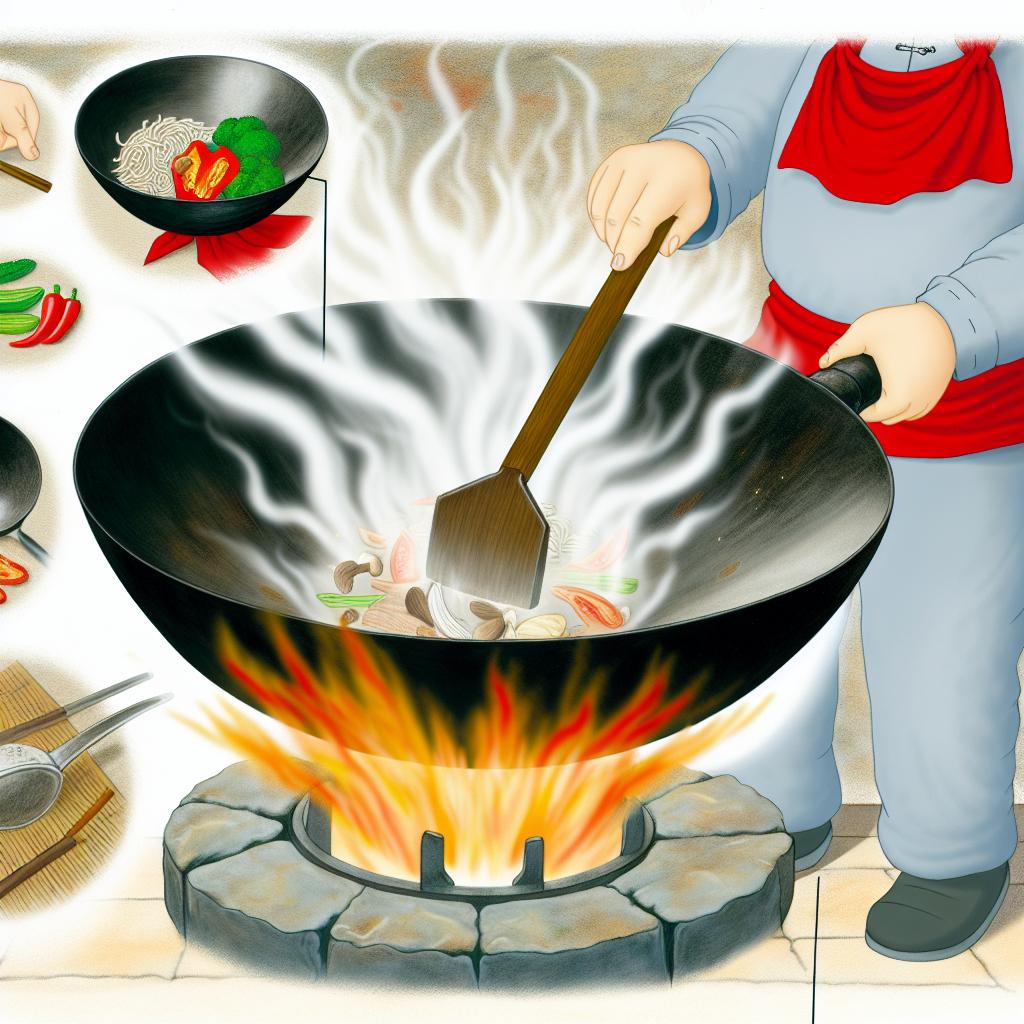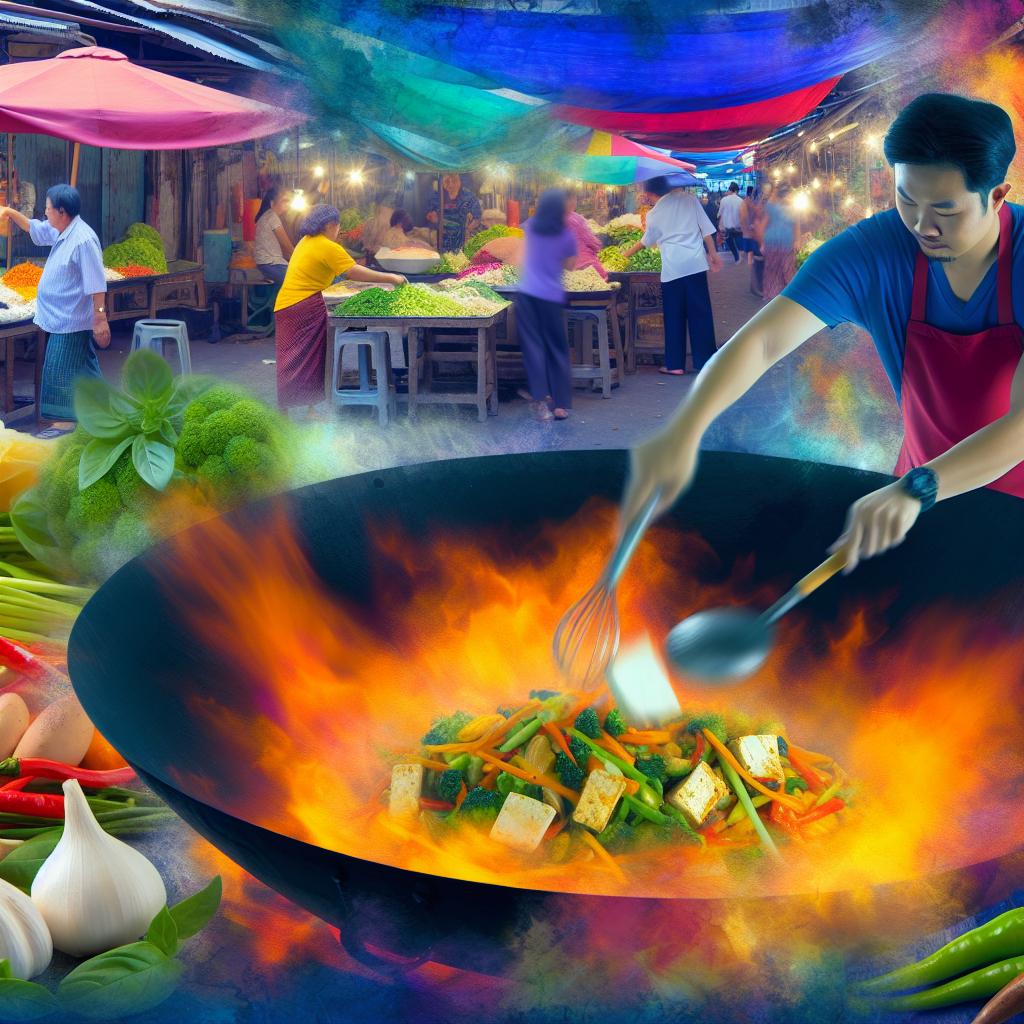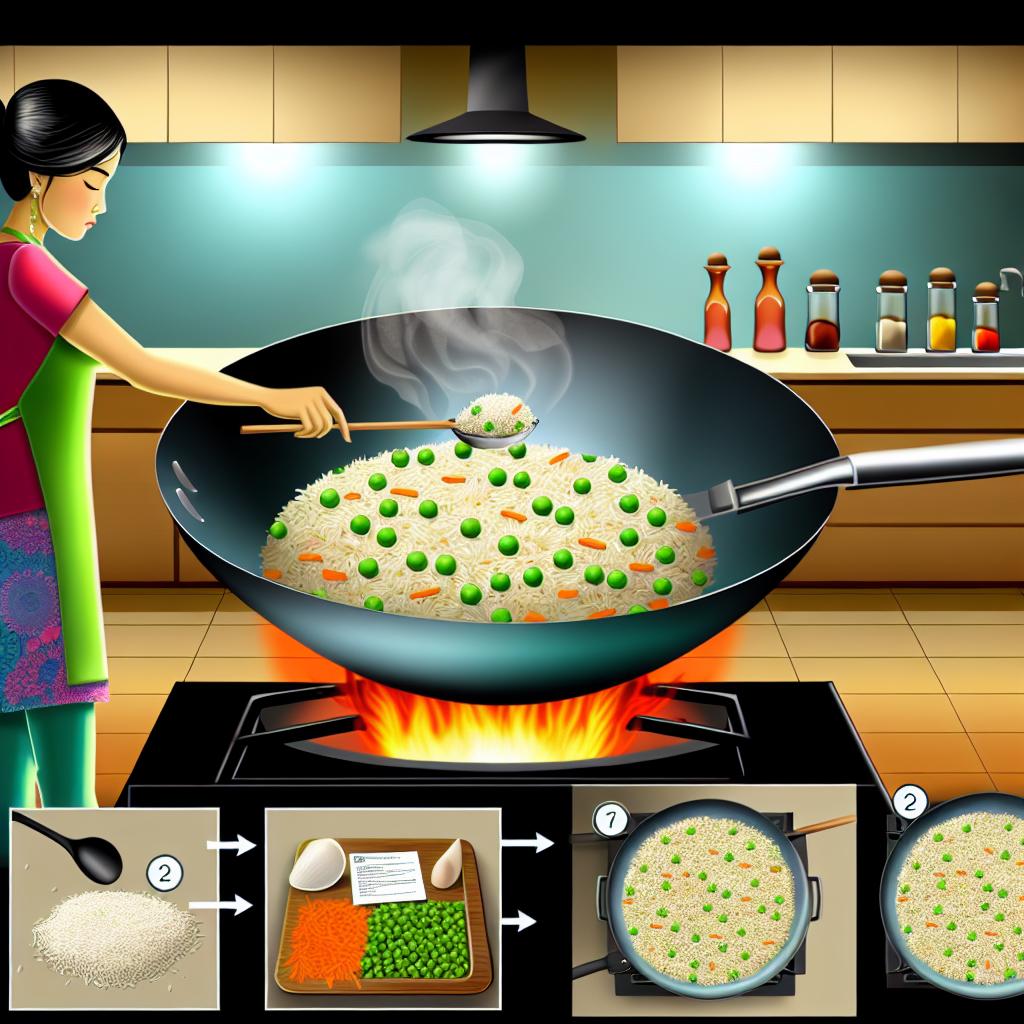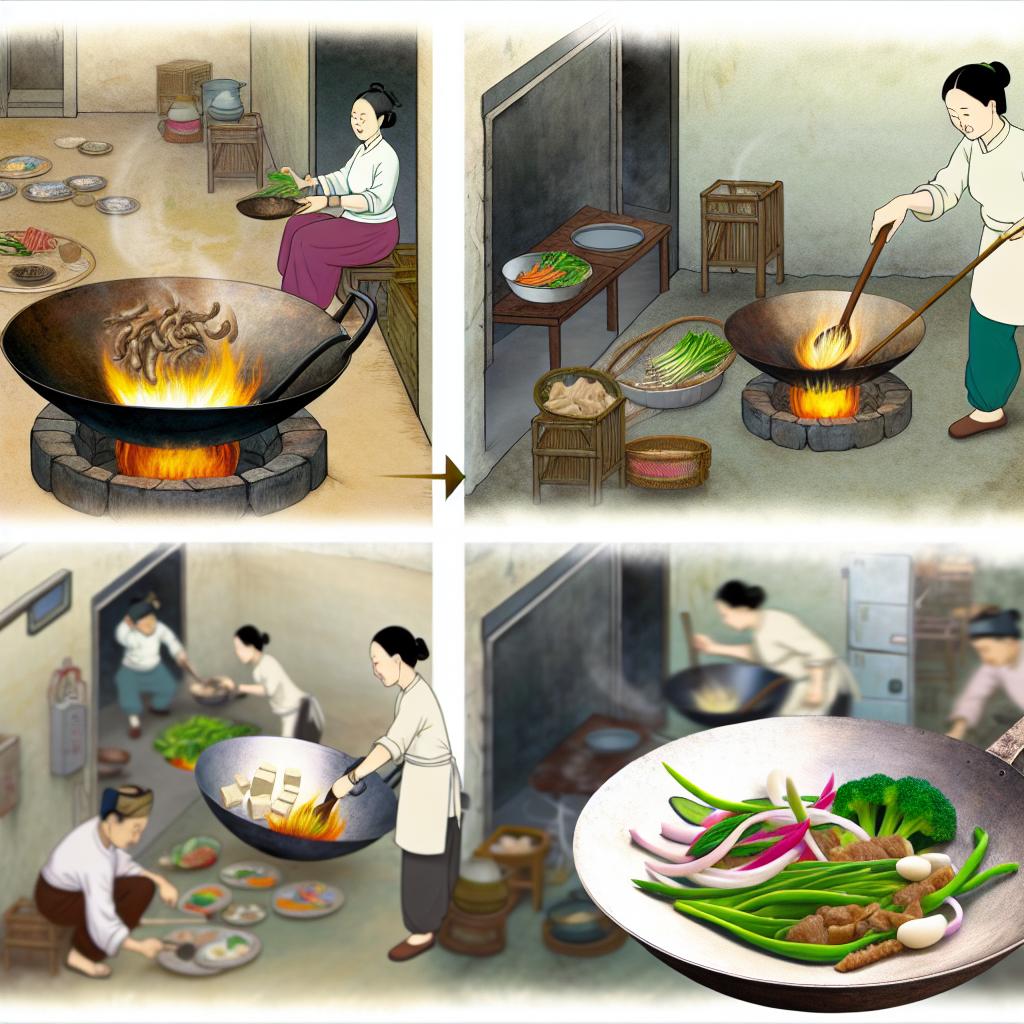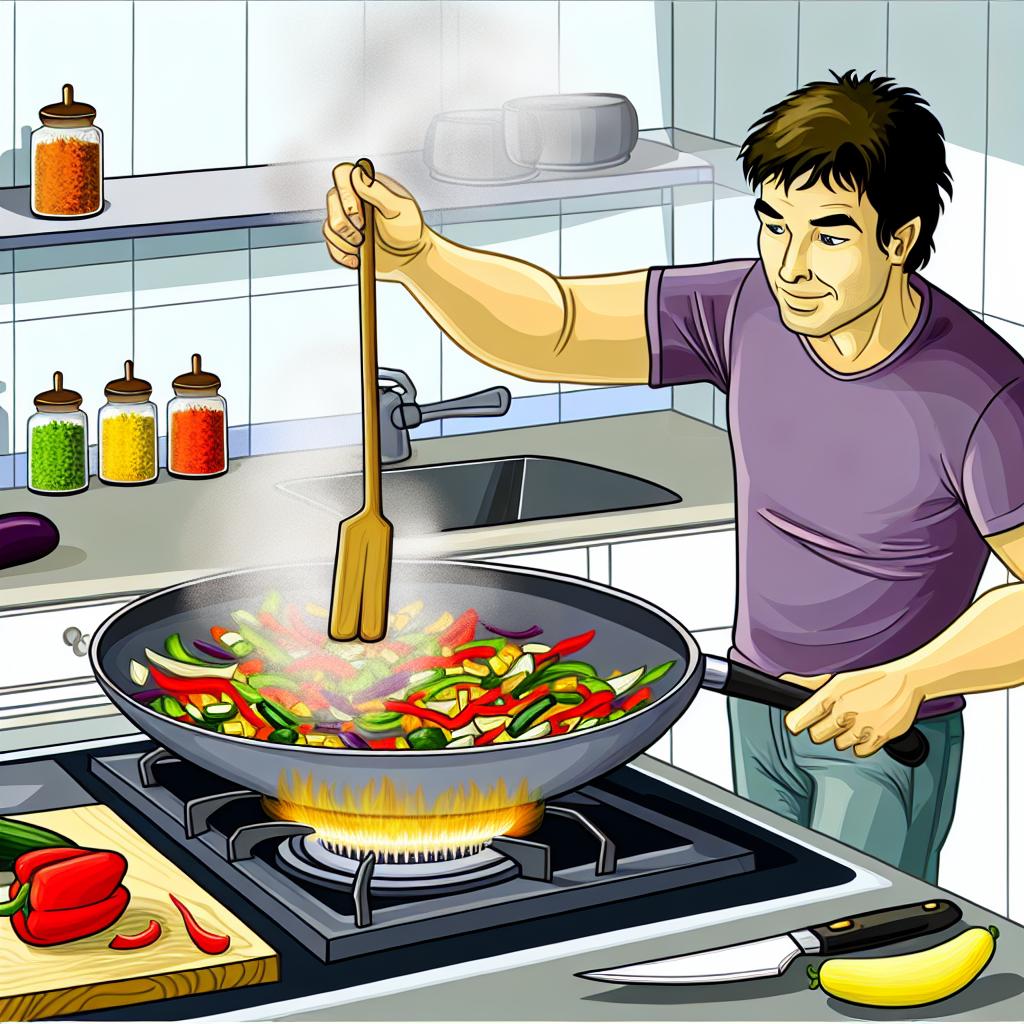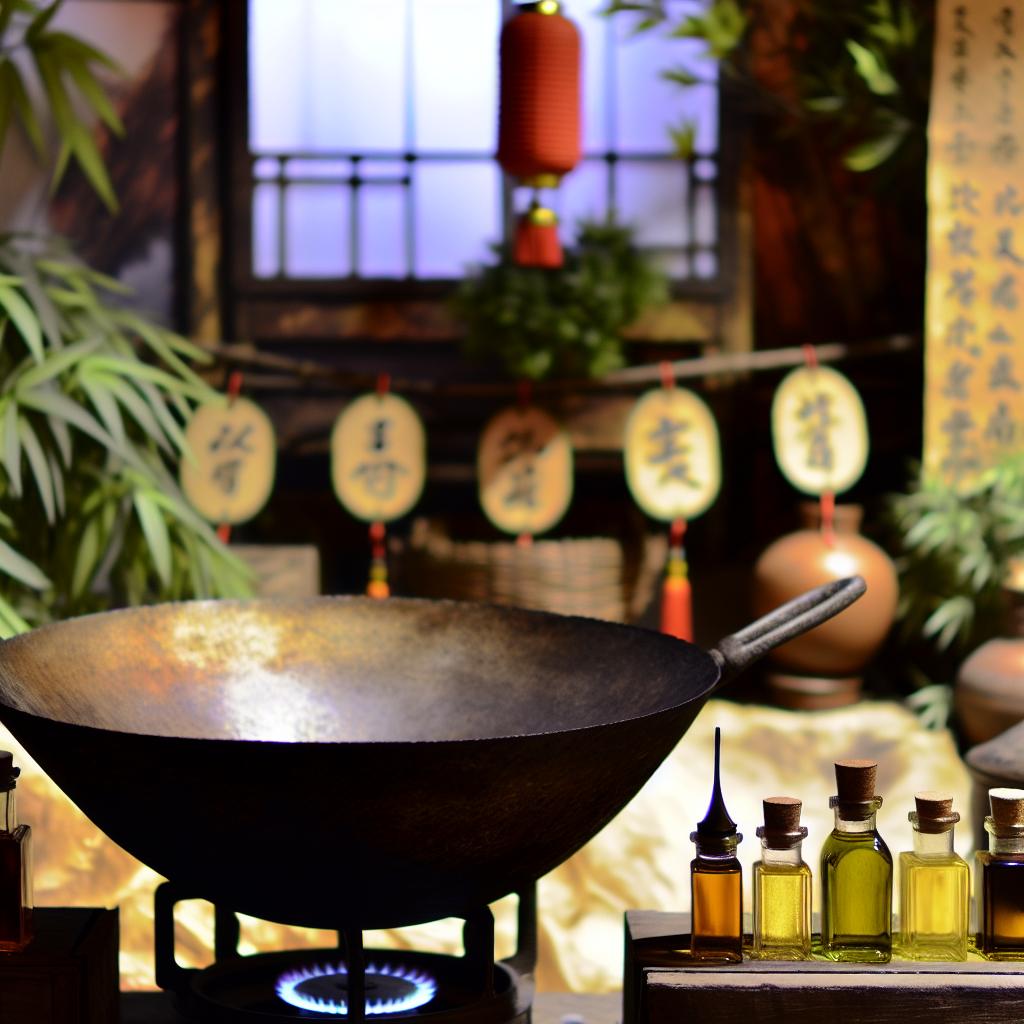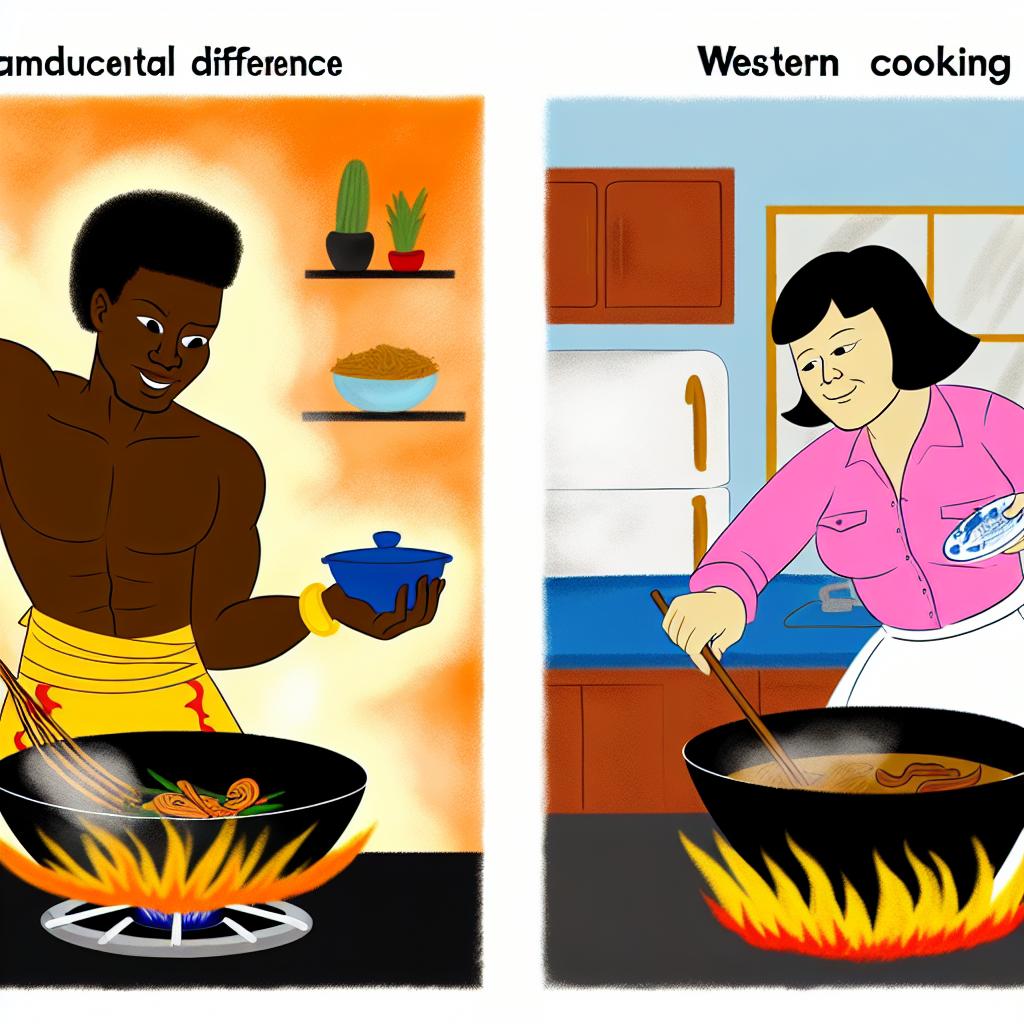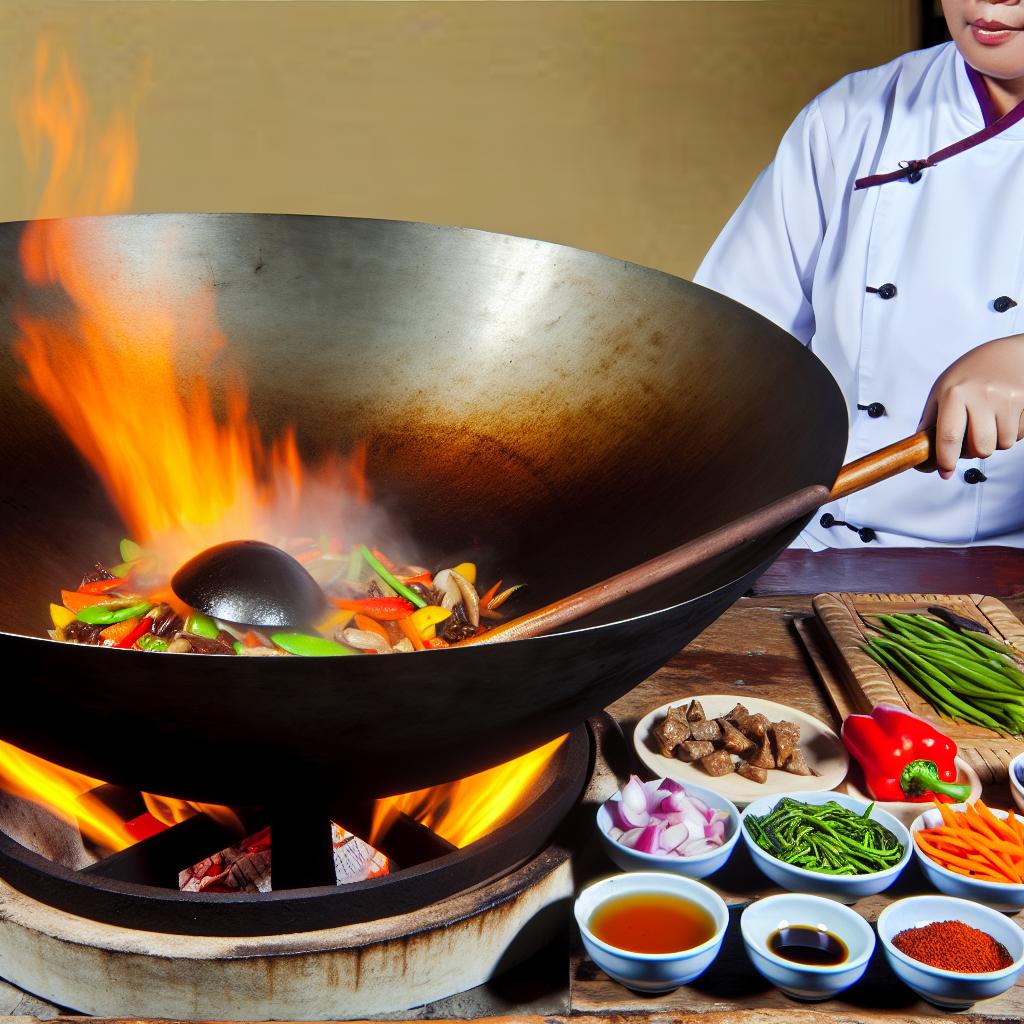Introduction
Cooking meat in a wok offers not just efficiency but also the enhancement of flavors, making it a favored method for many. The unique design of the wok, coupled with high heat, ensures that the meat is cooked evenly while preserving its natural juices and flavors. The blend of science and art in wok cooking can elevate your culinary skills, resulting in a delicious meal. This article will delve into the various techniques and factors that contribute to maximizing flavor when cooking meat using a wok.
The Benefits of Using a Wok
The design of a wok is specifically tailored for high-temperature cooking. It provides advantages that are not easily replicated by other cooking utensils. The most notable feature is the sloped sides, which facilitate quick stirring and flipping of ingredients. This prevents food from sticking, a common issue in traditional flat-bottomed pans. Cooking with a wok promotes even heat distribution, which is essential for ensuring that every piece of meat is cooked uniformly.
Additionally, the wok’s ability to deliver a distinct smokey flavor is unmatched, and it is this characteristic flavor that many associate with authentic stir-fries. The high-heat environment of the wok allows for the development of complex flavors that enrich the overall taste of the dish.
Choosing the Right Meat
Selecting the appropriate meat is fundamental in wok cooking. The ideal cuts of meat should be those that can withstand high heat and cook quickly. Understanding the nature of different meat cuts helps in making informed choices.
Thin cuts are particularly well-suited for wok cooking. Meat such as beef strips, chicken slices, and pork loin are preferred due to their relatively low fat content and tender texture. They respond well to quick cooking, ensuring that they remain tender and flavorful.
Size consistency is also critical in ensuring that the meat cooks evenly. Cutting the meat into uniform pieces prevents some pieces from being overcooked while others are left underdone. Although a slightly thicker piece may add a bit more cook time, it also provides some tolerance against overcooking, which can make the meat tough.
Preparation Techniques
Success in wok cooking is significantly influenced by how well the meat is prepared before it even touches the heat. A few essential techniques can significantly impact the outcome.
Marination: Allowing the meat to soak in a well-crafted marinade can impart additional flavors and help tenderize the meat. A classic marinade might include ingredients such as soy sauce, ginger, garlic, and a hint of oil. These components not only enhance the flavor but also break down the protein structure, leading to a more tender bite. A minimum marination time of 20 minutes is recommended to allow the flavors to penetrate the meat.
Drying the meat: For optimal browning, it is crucial to remove excess moisture. Pat the meat dry using paper towels before adding it to the hot wok. This step is vital because moisture can cause the meat to steam rather than sear, impeding the development of the desired crust.
Cooking Process
Heat Management
One of the first steps in cooking with a wok is appropriately managing heat. Preheating the wok until it is almost smoking ensures that the temperature is high enough to sear the meat effectively. This high-heat environment facilitates the Maillard reaction—a chemical process responsible for browning—which contributes to the depth of flavor in cooked meats.
Oil Selection
Choosing the right type of oil is crucial for wok cooking. Oils with a *high smoke point*, such as peanut or vegetable oil, are ideal. These oils can withstand the intense heat without breaking down, ensuring that the meat’s natural flavors are not overshadowed by burnt oil residues.
Stir-Frying Technique
Once the wok is properly preheated, add a small amount of oil and rotate the wok to coat it evenly. Quickly introduce the prepared meat, arranging it in a single layer. This maximizes contact with the hot surface, facilitating a swift sear. Use a metal spatula or a wok spoon to continuously toss the meat. This technique prevents it from adhering to the wok and ensures even cooking, which is essential for achieving a consistent texture and taste. As the meat transforms, it will take on a brown hue and develop a crispy crust that holds in the juices.
Additional Flavor Enhancements
To add layers of flavor, incorporate aromatics toward the tail end of the cooking process. Ingredients such as garlic, ginger, and onions are excellent choices. Adding them later prevents them from burning, thus ensuring that their essential oils and flavors are released without the bitter taste that results from overcooking. These aromatics elevate the overall flavor profile of the dish, enhancing the inherent tastiness of the meat.
Serving Suggestions
Once the meat reaches your desired level of doneness, remove it from the wok and allow it to rest briefly. This resting period enables the juices to redistribute throughout the meat, resulting in a juicier and more flavorful bite. For a complete meal, pair the seared meat with stir-fried vegetables, rice, or noodles. This approach creates a balanced dish, offering a satisfying combination of proteins, carbohydrates, and fibers.
Conclusion
Cooking meat in a wok is an art form that, when executed properly, transforms basic ingredients into a dish rich with flavor and texture. Wok cooking is not just about the ingredients; it’s a technique that, with proper execution, unlocks complex flavors making every bite memorable. By choosing the right meat, utilizing effective preparation techniques, and employing proper cooking processes, you can achieve restaurant-quality results in your own kitchen. For those interested in exploring further, numerous culinary resources and expert blogs can provide additional insights and recipes to elevate your wok cooking experience to new heights.
Understanding Wok Cooking
Wok cooking is a versatile and efficient culinary method that has its roots deeply embedded in Chinese cuisine. This method utilizes a round-bottomed pan, the wok, to facilitate quick cooking of food over high heat. An integral part of Asian culinary traditions, the wok’s unique shape allows for an even distribution of heat, enhancing the overall cooking process. This design is particularly advantageous for allowing cooks to toss foods with ease, ensuring even cooking without risking loss of the ingredients over the pan’s edges. It’s not just the heat distribution and efficiency that make wok cooking special; the method is also highly suitable for vegetables, as it preserves their intrinsic nutrients, pleasing textures, and vibrant colors.
Key Considerations for Choosing Vegetables
Selecting the right vegetables is crucial when it comes to wok cooking. Understanding the texture and cooking time of vegetables can greatly impact the final dish’s success. It is essential to choose vegetables that can withstand the high temperatures typical of wok cooking. They should be capable of maintaining their crunch and structure even under intense heat. Vegetables that are high in water content or those with a tendency to cook rapidly are deemed ideal for this cooking style, as they can resist becoming mushy and preserve their unique flavors and textures.
Commonly Used Vegetables
A variety of vegetables work exceptionally well in a wok, playing an integral role in many delicious dishes. Here are some of the more popular choices:
Bell Peppers: Bell peppers are renowned for their vibrant colors and sweet, mild flavors. When cooked in a wok, they retain their crispness, adding both visual appeal and nutritional benefits to any dish.
Broccoli: Known for its sturdy texture, broccoli is an excellent choice for wok cooking. It maintains its bright green color and offers a satisfying crunch, which contrasts with other softer ingredients in a meal.
Snow Peas: Snow peas cook quickly and are naturally sweet. They bring a refreshing element to wok dishes and require minimal preparation, making them a convenient and tasty addition to any recipe.
Bok Choy: Often referred to as Chinese cabbage, bok choy brings a mild flavor that complements a variety of sauces. Its tender leaves and crisp stalks provide a delightful textural contrast in the wok.
Carrots: These can be thinly sliced to offer a touch of sweetness and vibrant color to any wok dish. Their firm texture holds up well during the rapid cooking process that is characteristic of wok use.
Lesser-Known Options
While the previously mentioned vegetables are commonplace in wok cooking, exploring lesser-known options can add diversity and excitement to your dishes:
Water Chestnuts: Known for their crunchy texture and subtle sweetness, water chestnuts are a staple in many Asian stir-fries. They maintain their crisp demeanor even after being subjected to the heat of the wok, making them an appealing ingredient.
Asian Eggplant: The Asian eggplant’s spongy texture allows it to absorb flavors exceptionally well, making it a delightful addition to any wok meal. It cooks quickly and harmonizes with a variety of ingredients.
Baby Corn: Often associated with Chinese cuisine, baby corn provides a mild sweetness and a satisfying crunch. It pairs well with various sauces and proteins, adding dimension to the overall meal.
Culinary Approach and Techniques
Achieving the best possible results in wok cooking requires adhering to several critical techniques. Firstly, it’s essential to cut vegetables uniformly. This ensures even cooking, preventing any ingredient from being under or overcooked. Preheating the wok until it’s extremely hot is another key step; adding oil and vegetables to a preheated wok helps in *searing* the vegetables, effectively trapping in both flavors and nutrients. Continuous stirring or tossing of the vegetables is recommended to prevent them from adhering to the wok, ensuring a smooth and enjoyable cooking process.
Furthermore, the proper use of heat is essential in wok cooking. High heat is part of what gives this cooking method its characteristic efficiency and flavor retention. It’s important to manage the heat carefully, as too much can cause burning, while too little can lead to steaming instead of frying, which might result in a loss of the desired texture.
Wok cooking can be further enhanced by experimenting with different oils and sauces. Oils with high smoke points, such as peanut or canola oil, are preferable as they can withstand the high temperatures without imparting any unwanted flavors. Sauces, ranging from soy to oyster, can be added to taste, allowing for significant flexibility and customization of dishes.
Finally, successful wok cooking also involves understanding the order of ingredient addition. Denser vegetables or proteins might require more cooking time, so they should go into the wok first. More delicate ingredients can be added toward the end to avoid overcooking.
For individuals eager to venture further into the world of wok cooking, many resources are available to assist in understanding different techniques, explore new recipes, and optimize the use of this versatile kitchen tool. You can delve deeper into the intricacies of this method by exploring culinary websites such as BBC Good Food and Epicurious, which offer valuable guidance and innovative recipes for both beginners and experienced cooks.
Understanding Wok Hei
Achieving wok hei, often translated as the “breath of the wok,” is a sought-after quality in Chinese cuisine, particularly in stir-fried dishes. It refers to the unique flavor and taste imparted by the high heat and seasoned patina of a well-used wok. This characteristic is often described as smoky, aromatic, and complex. While it might appear mysterious, wok hei can be attained with the right techniques and understanding.
The Importance of Heat
The cornerstone of achieving wok hei is the use of extremely high heat. Traditional Chinese chefs use powerful burners that exceed 20,000 BTUs, enabling the quick, intense cooking required to induce aromatics and flavors. For home cooks who lack industrial-grade equipment, maximizing the heat output from their stoves becomes vital. One crucial step is to preheat the wok thoroughly before adding oil or ingredients. This step ensures that the oil is hot enough to initiate essential chemical reactions, such as the Maillard browning and caramelization processes, both of which contribute to the intricate flavors affiliated with wok hei.
Choosing the Right Wok
The choice of wok affects your ability to achieve wok hei. Carbon steel woks are highly recommended due to their excellent heat conductivity and capability to develop a seasoned patina over time. This seasoned layer not only makes the wok non-stick but also enhances the food’s flavor profile, which is crucial for achieving wok hei. Cast iron woks, although capable, need more time to change temperature due to their thickness and might not respond as quickly to heat adjustments as their carbon steel counterparts.
Proper Seasoning
Proper seasoning of a wok is a critical step in preparing it for effective cooking. If your wok is made of carbon steel, you should remove any factory coating first. This can be done by washing it with hot water and a little dish soap. Once cleaned, the wok needs to be dried thoroughly and heated until it changes color slightly. Then, a thin layer of oil should be applied and heated until it begins to smoke. Repeating this process several times helps build up a protective, non-stick coating that not only enhances cooking but also contributes significantly to the flavors indicative of wok hei.
Techniques in Stir-Frying
The techniques employed during stir-frying are as essential as the tools to mastering wok hei.
Control the Ingredients: Ensure all ingredients are at room temperature before cooking to prevent them from releasing excess moisture, which can cool the wok and hinder the high-heat cooking process. Moreover, ingredients should be cut into uniform sizes. This uniformity ensures that everything cooks evenly and no single ingredient compromises the heat required to achieve wok hei.
Order of Cooking: Sequence is critical. Begin by heating your wok until it gives off a slight smoke, then add oil. Let the oil heat as well before introducing aromatics such as garlic, ginger, or scallions. These are briefly sautéed to release their essential oils. Proteins come next, and should be seared quickly. Spread them out in the wok and avoid stirring immediately to allow them to sear effectively. Finally, introduce vegetables, sauces, and seasonings to round off the dish.
Movement and Tossing: Constant movement is another cornerstone of attaining wok hei. Using a spatula, stir and toss the ingredients relentlessly. This not only prevents items from burning but ensures that every piece of food is equally exposed to the high heat necessary for wok hei.
Experiment and Practice
The road to mastering wok hei is paved with patience and practice. It requires ongoing experimentation, starting with small quantities to maintain high temperatures effectively. Over time, as you become more comfortable with the nuances of heat and timing, the elusive ‘breath of the wok’ becomes more attainable.
Practicing these steps will greatly enhance your skills in stir-frying, potentially allowing you to elevate a simple dish into something truly memorable. With dedication and the application of the tips mentioned above, anyone can begin to capture the essence of wok hei in their own kitchen, enhancing both their culinary skills and dining experiences.
For those who wish to delve deeper, numerous resources and video demonstrations are available, providing valuable insights into authentic Asian culinary techniques. These resources can offer guidance and visual aids to further refine your skills in achieving the impeccable balance of flavor and aroma that is wok hei.
The Significance of Wok Cooking in Southeast Asian Cuisine
The wok is an indispensable tool in Southeast Asian kitchens, renowned for its versatility and efficiency. Originating from China, the wok has become an integral part of the culinary landscape across Southeast Asia, influencing cooking techniques and flavors in countries such as Thailand, Vietnam, Malaysia, and Indonesia.
Versatility and Design
The unique design of the wok, with its rounded bottom and high sides, makes it suitable for a variety of cooking methods. This includes stir-frying, deep-frying, boiling, steaming, and braising. The sloped sides allow for quick and even distribution of heat, which is crucial for the rapid cooking methods often employed in Southeast Asian cuisine. This efficiency not only saves time but also preserves the nutritional content and freshness of the ingredients.
Beyond these common methods, the wok’s design allows it to adapt to other cooking techniques unfamiliar to the common home cook but often utilized by chefs aiming for authenticity. The high sides are perfect not only for preventing spills but also for turning and flipping ingredients without fear of losing them, a technique essential in professional kitchens where speed and precision are of the essence. Moreover, because the heat is concentrated at the bottom, chefs can control specific cooking points, enabling ingredients that require more or less heat exposure to be adjusted accordingly.
Contribution to Flavor
A significant aspect of wok cooking is its ability to enhance flavors through a technique known as “wok hei” or the “breath of the wok.” This elusive quality is achieved by cooking over an extremely high heat, which imparts a distinctive smoky flavor to the food. This technique is particularly evident in dishes like Thai Pad Ka Prao and Malaysian Char Kway Teow, where rapid cooking at high temperatures helps combine the flavors of various herbs and spices.
The mastery of wok hei is often considered an art in itself. Achieving it requires not just a hot wok but the precise timing and sequence of introducing ingredients. When mastered, it allows the flavors to develop in an ideal chemistry and timing that brings components together harmoniously. Moreover, wok hei is not limited to smoky flavors alone; it enhances savory and umami properties, making the meal more satisfying to the palate.
The Importance in Cultural Practices
Wok cooking is deeply embedded in the culinary traditions and daily practices of Southeast Asia. Its use reflects local preferences for fresh, quickly cooked meals, which align with the region’s hot and humid climate. Preparing food in this manner not only accentuates the vibrant flavors of indigenous ingredients like lemongrass, galangal, and kaffir lime leaves but also accommodates the fast-paced lifestyle prevalent in many Southeast Asian cities.
Moreover, the communal aspect of preparing and sharing food cooked in a wok is significant in fostering social interactions among families and communities. For more insights on the cultural significance of Southeast Asian cuisine, you can visit this resource.
In many Southeast Asian cultures, food is more than sustenance; it is a time for family bonding and community gathering. The wok, often seen as a symbol of unity and shared tradition, plays a central role in these gatherings, from street food stalls bustling with diverse offerings to family kitchens where recipes are passed down generations. The ability to quickly serve large quantities of food makes the wok vital during festivals and family celebrations.
Influence on Modern Culinary Practices
With globalization, wok cooking has crossed geographical boundaries to influence restaurant kitchens and home cooks around the world. This has led to a fusion of culinary techniques, where the traditional methods of Southeast Asian wok cooking have been integrated with local ingredients and preferences. This global reach highlights the enduring appeal and adaptability of the wok as a culinary tool.
Globally, chefs and home cooks alike have adapted wok techniques to a variety of cuisines, progressively challenging the traditional boundaries of what a wok can do. From incorporating non-traditional ingredients to adjusting techniques for different stove types and heat sources, the wok’s role in the modern culinary world demonstrates its flexibility not only in technique but in enhancing cross-cultural culinary exchanges.
Conclusion
In summary, the wok plays a vital role in Southeast Asian cuisine, enhancing flavor, preserving nutritional value, and supporting cultural practices. Its versatility makes it a crucial instrument in the rapid preparation of meals that are both flavorful and nutritious. As culinary exploration continues to grow globally, the wok remains a central pillar in the evolving landscape of both traditional and modern cuisines.
Cooking with a wok offers a unique lens through which we can appreciate the richness of Southeast Asian culinary traditions. More than just a cooking vessel, it embodies cultural pride, culinary excellence, and innovative adaptability, securing its role as a timeless element in kitchens worldwide. As people continue to explore diverse cooking methods and global flavors, the wok will undoubtedly remain an essential tool for both aspiring and seasoned cooks seeking to expand their culinary repertoire. This continued relevance underscores the wok’s significance not only as a historical artifact but as an evolving culinary instrument adapting through time and trend.
Introduction
Fried rice is a beloved dish, renowned for its adaptability and capability to transform leftover ingredients into a delightful meal. The culinary world appreciates its versatility and the unique taste that emerges from the simple act of stir-frying rice. A wok, with its distinct shape and heat distribution properties, stands out as the optimal tool for preparing fried rice. Its concave design allows for an even distribution of heat, ensuring that each grain is cooked uniformly and that flavors meld together harmoniously.
Key Ingredients
In crafting a delectable fried rice dish, there are several core ingredients that serve as the foundation to achieve the desired texture and taste.
Rice: The cornerstone of this dish is day-old rice. The reason for this lies in its reduced moisture content. Overnight, the rice dries out slightly, making it perfect for frying as it becomes less sticky and better at absorbing the myriad flavors from spices and sauces. Using freshly cooked rice, on the other hand, often results in a gummy and clumpy dish, detracting from the ideal texture of fried rice.
Soy Sauce: This ingredient is essential for introducing the characteristic salty and umami flavor to fried rice. The magical component of soy sauce lies in its ability to season the rice and unify the dish. It’s advisable to adjust the quantity according to individual taste preferences.
Vegetables: A medley of vegetables not only enhances the dish’s nutritional value but also adds a vibrant aesthetic appeal. Common selections include peas, carrots, and spring onions. The integration of varied colors into the dish can make it visually captivating.
Protein: Fried rice can be a one-pot meal, especially with the addition of protein options such as chicken, shrimp, or tofu. The chosen protein not only satisfyingly increases the dish’s nutrition but also contributes additional texture and flavor.
Eggs: The incorporation of eggs is pivotal as it introduces an extra layer of texture and enriches the flavor profile. The manner in which eggs are scrambled and incorporated into the dish can significantly impact the final taste and appearance.
Preparation Steps
Effective preparation and a methodical approach are essential for creating a successful fried rice dish.
1. Prepare the Ingredients: Before initiating the cooking journey, ensure meticulous preparation of all ingredients. Dicing the vegetables, beating the eggs, and having the soy sauce, oil, and protein ready are crucial steps that facilitate a smooth cooking process.
2. Heat the Wok: Heat control is significant when using a wok. Begin by setting your stove to a medium-high temperature to start warming the wok. Adding a minimal amount of oil, preferably one with a high smoke point like canola or peanut oil, ensures a smooth cooking process without burning the ingredients.
3. Cook the Protein: The chosen protein should be the first to go into the heated wok. Cooking the protein separately ensures it is cooked completely and achieves the desired texture. Once cooked, it should be removed from the wok and set aside.
4. Scramble the Eggs: Next, add the beaten eggs to the still heated wok. Scramble them until they are just cooked through. They should be soft yet firm. Once complete, remove them from the wok and set them aside with the protein.
5. Stir-fry Vegetables: After clearing the wok, it may be necessary to add a bit more oil before introducing the vegetables. Stir-fry them until they’re tender yet maintain a slight crispness, signaling that they are cooked to perfection.
Combining the Ingredients
The combining of individual components is where the fried rice truly comes together.
6. Add the Rice: Prior to adding the rice, reduce the stove to medium heat. Integrate the cold, day-old rice into the wok carefully. Use a spatula to gently break apart any clumps, ensuring that each grain heats evenly while allowing the flavors to integrate properly.
7. Incorporate Soy Sauce: Pour the soy sauce uniformly over the rice. Using your spatula, toss the rice swiftly and confidently, helping to coat every grain evenly. This step guarantees the rice absorbs the soy sauce’s flavor throughout.
8. Return Eggs and Protein: Reintroduce the cooked eggs and protein back into the wok. Mix them thoroughly with the rice and vegetables, allowing the flavors and textures to meld seamlessly.
9. Final Touches: As you approach the end of the cooking process, adjust the seasoning according to your taste. If desired, a final splash of sesame oil can be added. This not only imparts an additional layer of flavor but also contributes a slight gloss to the dish’s appearance.
Common Mistakes to Avoid
In order to achieve the perfect fried rice, it’s important to be aware of common pitfalls.
Using Fresh Rice: Opting for freshly cooked rice is often the downfall of achieving the ideal texture. Always use rice prepared a day in advance to maintain the dish’s intended consistency.
Overcrowding the Wok: A wok functions best when ingredients have space. Overcrowding can lead to steaming rather than frying of the components, which affects the dish’s texture and flavor.
Neglecting Preparation: The secret to a smooth cooking process lies in preparation. Any delay due to last-minute ingredient preparation can negatively impact the final product.
Conclusion
Creating perfect fried rice in a wok demands meticulous attention to detail, with a particular focus on ingredients and timing. Each step, from preparation to the final touches, plays a critical role in crafting a dish that is not only delicious but also satisfying. Should there be a desire to explore further advice and variations on traditional fried rice recipes, culinary resources like Food Network or BBC Good Food offer a wealth of information.
Introduction to Stir-Frying
Stir-frying, a renowned cooking technique deeply rooted in Chinese cuisine, has played a crucial role in the development of culinary practices in China and beyond. It is a method that involves cooking ingredients quickly at a high temperature in a small amount of oil. The result is a flavorful dish with a distinct texture that has captivated food enthusiasts worldwide. This method is not only about technique but also about cultural exchange, history, and adaptation, making it a fascinating subject for culinary exploration.
Origins and Historical Context
The origins of stir-frying can be traced back to ancient China. Some historians believe that the practice began during the Han Dynasty (206 BC – 220 AD), although archaeological evidence suggests cooking methods resembling stir-frying may date back even further. Ancient Chinese texts and inscriptions provide evidence of food preparation techniques that focus on quick cooking processes, which are integral to what we now know as stir-frying. The technique cemented its place in Chinese cuisine during the Tang Dynasty (618-907 AD) when advancements in metallurgy led to the creation of the wok, a versatile cooking utensil integral to stir-frying. This period also saw an increase in urbanization and a shift in dietary practices, setting the stage for stir-frying to become a mainstream cooking method in Chinese households.
Development and Popularization
The popularity of stir-frying surged during the Song Dynasty (960-1279 AD), a period known for significant cultural and economic growth. The bustling cities of the Song era, characterized by small kitchens and limited cooking fuel, found stir-frying to be both practical and efficient. The technique’s efficiency and ability to preserve the nutritional value of ingredients made it a favored choice among the burgeoning urban population. In addition to practicality, stir-frying catered to the Confucian emphasis on balance and moderation in food, helping to cement its role in Chinese culinary ethos.
As trade routes expanded during the Ming (1368-1644) and Qing (1644-1912) dynasties, stir-frying began to reach other parts of Asia and eventually the Western world. The spread of this technique was facilitated by the migration of Chinese communities and the globalization of Chinese cuisine. Adaptations of stir-frying techniques appeared in various cultures, each incorporating local ingredients and flavors, which added new dimensions to this timeless cooking method.
The Role of the Wok
Central to stir-frying is the use of a wok, a round-bottomed cooking vessel that allows for even heat distribution and the efficient cooking of ingredients. The design of the wok enables food to be cooked quickly at high temperatures, preserving flavor and texture while maintaining nutrition. Its flared sides make it easy to toss ingredients, ensuring even cooking and blending of flavors. Over time, the wok has become synonymous with Chinese cooking, and its design has evolved to accommodate various heat sources, including gas, electric, and induction cooktops. The versatility of the wok has made it an essential tool in many kitchens around the world.
Modern Implications and Global Influence
Today, stir-frying is not confined to China but is a popular cooking technique in many countries. Its global influence is evident in the incorporation of stir-frying into other culinary traditions, which has led to the development of fusion cuisines that blend stir-frying with local ingredients and flavors. This fusion has enriched culinary traditions worldwide, giving rise to new tastes and innovations while preserving the integrity of the original stir-frying technique.
In contemporary kitchens, stir-frying continues to be revered for its speed, efficiency, and ability to create dishes that are both tasty and nutritious. Many culinary schools and cooking classes around the world teach stir-frying as an essential skill, making it a foundational technique for professional and home cooks alike. The appeal of stir-frying also lies in its adaptability, allowing cooks to experiment with a variety of ingredients, from vegetables and meats to tofu and seafood, creating a myriad of possibilities.
The history of stir-frying in Chinese cuisine highlights not only the evolution of cooking methods but also the cross-cultural exchanges that shape culinary traditions worldwide. It serves as an excellent example of how a cooking technique can transcend its origins and become part of a global culinary language. For more detailed explorations on this topic, various resources provide in-depth analyses and discussions on the broader historical impacts of Chinese culinary practices.
Beyond its culinary applications, stir-frying reflects broader societal changes, from technological advancements in cookware to shifts in dietary habits and urbanization. As we continue to explore and appreciate this technique, it is essential to recognize its role in fostering cultural connections and culinary innovation across the globe. As such, stir-frying represents a dynamic intersection of history, culture, and cuisine—a testament to the enduring power of food to bring people together in shared tradition and new experimentation.
Understanding the Basics of Stir-Frying
Stir-frying is a renowned culinary technique with roots firmly planted in Chinese cuisine. It has gained global popularity due to its efficiency, versatility, and the delicious results it yields. This technique involves the rapid cooking of small, uniformly cut pieces of ingredients in a modest amount of hot oil over high heat. The primary aim is to achieve a delightful combination of textures and flavors while preserving the nutritional content of the dish. Let’s delve deeper into the art of stir-frying, exploring essential tools, ingredient selection, and effective preparation and cooking methods.
Essential Tools and Equipment
To master the art of stir-frying, having the appropriate tools is crucial. The traditional choice for this technique is a wok. The wok’s unique shape, often compared to a rounded bowl, allows for exceptional heat distribution and makes it easier to toss ingredients. For those serious about stir-frying, a carbon steel wok is recommended. Its ability to heat up swiftly and evenly ensures that ingredients are cooked to perfection.
However, if a wok is not readily available, you can substitute with a large, heavy-bottomed frying pan. Regardless of choice, the pan should enable the rapid movement of ingredients during cooking. Additionally, a long-handled spatula or wooden spoon is essential for stirring and flipping the food, preventing any stagnant items from sticking and ensuring uniform cooking.
Choosing the Right Ingredients
Selecting the right ingredients is fundamental to creating a successful stir-fry. A balanced combination typically includes proteins, vegetables, and aromatics. For proteins, choose from a range of options such as chicken, beef, tofu, or shrimp. These ingredients should be thinly sliced to facilitate fast cooking. When it comes to vegetables, diversity is key. Select those with contrasting textures and vibrant colors like bell peppers, broccoli, or carrots. They not only enhance the dish’s appearance but also provide a range of flavors and nutrients.
Aromatics play a pivotal role in amplifying the flavor profile of a stir-fry. Ingredients such as garlic, ginger, and shallots are staples in many stir-fry recipes. Their fragrant essence permeates the dish, adding depth and complexity to the overall taste.
Preparation Techniques
Preparation is as important as the cooking itself in achieving a top-notch stir-fry. Begin by ensuring all ingredients are uniformly cut. This consistency allows for even cooking, preventing some items from being overdone while others remain undercooked. Meanwhile, marinating proteins beforehand can infuse them with additional flavors and tenderize them. A recommended marinade can be simple yet effective, comprising soy sauce, cornstarch, and a touch of oil. This mixture not only enhances the protein’s flavor but also helps in achieving a delightful texture.
Maintaining High Heat
Correct temperature management is vital in the stir-frying process. High heat is essential to cook the ingredients swiftly and evenly. It is crucial to preheat the wok until it becomes very hot before introducing any ingredients. Add oil when the wok is sufficiently heated—it should shimmer as it hits the wok but should not reach the point of smoking. This ensures that the ingredients can develop a slight sear or browning that intensifies their flavor.
Executing the Stir-Fry
The execution of a stir-fry involves more than just tossing all ingredients into the wok simultaneously. Instead, add components in stages based on their respective cooking times. Start with aromatics as they form the base of your flavor. Once they release their fragrance, introduce proteins, which generally require a bit more time to cook thoroughly. Finally, add vegetables, starting with those needing longer to cook to those that are quicker within seconds. This staggered approach guarantees that each ingredient reaches its optimal texture and flavor.
The Importance of Constant Movement
Throughout the stir-frying process, maintaining a constant movement of ingredients is crucial. This can be achieved by continuously stirring and tossing them in the pan. This motion ensures that everything cooks evenly and prevents individual pieces from sticking to the surface and burning. Constant movement also helps to retain the natural moisture of the ingredients, preserving their nutritional benefits.
Finishing Touches
As the cooking nears completion, it’s time to think about the sauce. A well-balanced sauce can elevate the flavor profile of the entire dish. The sauce should be added towards the end of cooking, so it lightly coats the ingredients without making them soggy. You can prepare a basic and flavorful stir-fry sauce using ingredients like soy sauce, sesame oil, and a bit of cornstarch mixed with water. This concoction acts as a binding element, harmonizing the diverse flavors within the dish.
Serving Suggestions
Stir-fry dishes are versatile and can be served with various accompaniments to create a complete meal. Often, they are enjoyed over rice or noodles, offering a satisfying base that complements the rich flavors of the stir-fry. Consider pairing your stir-fry creation with steamed rice for an authentic touch, or for a slightly more indulgent option, serve it alongside fried rice. Noodles also make a great partner, offering different textures and taste profiles.
The beauty of stir-frying lies in its adaptability, both in ingredients and accompaniments. This technique allows for endless experimentation, enabling cooks to explore different combinations and adjustments to suit various dietary needs and preferences. With the foundational understanding of stir-frying under your belt, the possibilities are vast, allowing you to craft meals that are not only quick and nutritious but also rich in flavor and diversity.
Introduction to Wok Cooking
Wok cooking is a multi-faceted culinary approach known for its efficiency and adaptability, playing a pivotal role in many Asian cuisines. This cooking style is characterized by its use of high heat and swift preparation, producing dishes that are not only flavorful but also richly textured. Within the realm of wok cooking, selecting the appropriate oil is a crucial step. The choice of oil significantly influences the dish’s flavor profile, texture, and nutritional benefits. This article delves into suitable oils for wok cooking, explaining their characteristics and applications.
Characteristics of Ideal Wok Cooking Oils
Before identifying specific oils, it is imperative to understand the attributes that make an oil appropriate for wok cooking. The key to successful wok cooking lies in its ability to achieve and maintain high temperatures. Therefore, one of the primary considerations when selecting oil is its smoke point.
Factors to Consider
Choosing the correct oil begins with evaluating several critical aspects:
– **Temperature Tolerance:** For wok cooking, it is essential to opt for oils with a high smoke point. Oils should be able to sustain temperatures of at least 400°F (204°C) as the oil needs to endure high heat without reaching its smoke point to prevent the development of undesirable flavors.
– **Flavor Neutrality:** The flavor of the oil can considerably alter the final dish. While some recipes might benefit from a pronounced oil flavor, others might require a neutral base to allow the primary ingredients to shine. Therefore, selecting an oil that complements the dish’s flavor profile is of utmost importance.
– **Nutritional Profile:** Oils differ in their health benefits. Some oils are richer in monounsaturated and polyunsaturated fats, which are linked to better heart health and general well-being. Incorporating oils with beneficial nutritional characteristics can enhance the overall healthfulness of a dish.
Recommended Oils for Wok Cooking
Various oils meet the criteria outlined above, providing both high performance and beneficial health properties, making them well-suited for wok cooking.
Peanut Oil
Peanut oil stands out as a top choice, renowned for its high smoke point, approximately 450°F (232°C), which comfortably handles the high heat levels of wok cooking. Its mild, nutty flavor enhances many traditional dishes without overpowering other ingredients. Moreover, peanut oil is abundant in monounsaturated fats, contributing to heart health. Its balanced fat profile and favorable smoking point make it a reliable option for both novices and seasoned chefs.
Soybean Oil
Soybean oil is notable for its availability and cost-effectiveness, making it a staple in many commercial kitchens. With a smoke point similar to that of peanut oil, about 450°F (232°C), soybean oil is resilient under high temperatures, offering consistency and reliability in cooking. Its neutral flavor ensures that it does not impose on the dish’s intended taste. Rich in polyunsaturated fats, soybean oil also delivers potential health benefits, such as improved cardiovascular health.
Sesame Oil
Sesame oil is unique due to its robust, distinctive flavor. While typically used as a finishing oil, it is available in a refined form, exhibiting a higher smoke point of approximately 410°F (210°C). When used judiciously, refined sesame oil can lend a unique flavor to wok-prepared dishes. The oil’s toasted variety is especially popular, often used sparingly to infuse finished dishes with its intense aroma and taste. Despite its lower smoke point compared to other recommended oils, its flavor properties may make it a desirable choice for certain recipes.
Canola Oil
Canola oil is praised for its versatility, possessing a moderately high smoke point of around 400°F (204°C), which suits wok cooking. Its unobtrusive flavor allows it to support dishes where the spices and ingredients take center stage. Furthermore, canola oil contains one of the lowest levels of saturated fat among cooking oils, which underscores its reputation as a heart-friendly option. Its availability and cost make it accessible for a wide audience, enhancing both everyday and specialty cooking.
Conclusion
In summary, selecting the appropriate oil for wok cooking hinges upon understanding each oil’s smoke point, flavor profile, and nutritional content. Oils such as peanut, soybean, sesame, and canola are commendable choices, all possessing high smoke points and certain health benefits. The key to successful wok cooking rests in harmonizing the choice of oil with the culinary requirements of the dish. Attention to these elements ensures the attainment of enhanced flavor, texture, and nutritional integrity in meal preparation. For those interested in refining their wok cooking techniques, further exploration into oil options and culinary resources can immensely enrich the cooking experience, potentially leading to new culinary discoveries.
Understanding the foundations of woking fuels innovation in the kitchen, marrying tradition with modern dietary sensibilities, and its multicultural reach provides an invaluable perspective on the art of culinary improvisation. These oils, serving as a medium for heat and flavor, exemplify how simple components within a dish can dictate the outcome, from taste to health benefits. Therefore, a conscious, informed selection of cooking oil is a fundamental aspect of culinary practice, especially when engaging in the vibrant and flavorful world of wok cooking.
Introduction
Wok cooking, deeply rooted in East Asian culinary traditions, presents a unique approach to preparing food that markedly differs from typical Western cooking methods. While both strive to achieve delicious, nutritious meals, the tools, techniques, and underlying principles often differ substantially. This exploration into the striking contrasts and occasional similarities between wok and Western cooking provides insight into not only their culinary practices but also the cultural aspects that shape these diverse approaches.
The Cooking Vessel: Wok vs. Western Pans
The wok is a signature symbol of East Asian cuisine, renowned for its unique design and versatility. Characterized by a distinctive round bottom, the wok functions as a multi-purpose kitchen tool that facilitates a variety of cooking techniques. Its design inherently allows for cooking at differing temperatures, making it an integral component of quick, efficient food preparation.
In contrast, Western kitchens primarily rely on an array of flat-bottomed pans and pots. These are designed to rest stably on flat stovetops, forming a crucial part of Western culinary traditions. The differences in design significantly influence cooking styles and the resultant flavors and textures of the dishes prepared.
Heat Distribution: One of the most defining characteristics of the wok is its heat distribution capability. Its round bottom ensures that heat is concentrated primarily at the base, while it gradually dissipates along the sides. This allows the cook to carry out high-temperature cooking at the bottom while simultaneously enabling gentler cooking up the sides. Western pans, with their flat surfaces, provide even heat distribution across the base, encouraging uniform cooking.
Material: Material choice also distinguishes the wok from Western cooking vessels. Traditional woks are crafted from carbon steel, a material that reacts swiftly to changes in temperature and develops a non-stick patina over time. Meanwhile, Western pots and pans are frequently crafted from materials such as aluminum, stainless steel, or cast iron, each offering different heat retention properties and cooking benefits.
Cooking Techniques
An exploration of cooking techniques reveals yet another layer of distinction between wok and Western culinary practices. Techniques inherently tied to the design of the cooking vessel play a pivotal role in defining the flavors and textures of the final dish.
Stir-Frying: Stir-frying stands at the center of wok cooking, involving the rapid cooking of ingredients over high heat while continuously stirring. This technique facilitates the retention of nutrients and flavors and is synonymous with the vibrant and aromatic profile of many Asian dishes. By contrast, Western kitchens frequently use methods like sautéing or pan-frying. Though similar in concept, these methods typically operate over lower heat and take longer time periods, resulting in different flavor development.
Deep Frying: The shape of the wok also lends itself to efficient deep frying, as less oil is needed compared to the flat-bottomed pans commonly used in Western kitchens. This contributes to a broader range of textures and efficiencies in the cooking process.
Temperature and Heat Control
Another defining characteristic of wok cooking is its emphasis on high heat. The ability to move ingredients to cooler sides allows for precise control over cooking speed and doneness, a technique less emphasized in Western kitchens where consistent, moderate heat is often preferred. This temperature management is crucial for achieving the characteristic flavors and textures that wok cooking is celebrated for.
Flavor Development
Wok Hei: The term ‘wok hei,’ translated as ‘breath of the wok,’ describes the unique flavor imparted by stir-frying in a wok. The intense heat and quick cooking result in a distinctive signature flavor that is much sought after. In Western culinary traditions, flavors often emerge through slower processes such as browning or caramelization, each method reflecting distinct cultural priorities and techniques.
Ingredients and Preparation
Preparation in wok cooking is rapid and efficient, often involving pre-cut ingredients to maintain texture and color during brief cooking times. The focus on quick, precise preparation reflects a culinary tradition that values freshness and immediacy. On the other hand, Western cuisine sometimes favors the use of whole or larger pieces of ingredients, necessitating longer cooking times which allow for flavor development through extended exposure to heat.
Role of Sauces and Seasonings
Another contrast lies in the role of sauces and seasonings. In wok cuisine, soy sauce, oyster sauce, and rice wine are frequently used to quickly enhance flavors. These components speak to a culinary tradition of bold, immediate taste modulation. Conversely, Western methods often emphasize techniques like reductions or emulsions that develop over longer periods, producing a more subtle flavor evolution.
Conclusion
In conclusion, both wok cooking and Western methods come with their distinct sets of advantages, each shaped by cultural traditions and culinary goals. By understanding these differences, cooks can enhance their individual techniques and broaden their appreciation and capabilities in the kitchen. These insights provide a gateway to mastering diverse global cooking practices and contribute to a rich culinary repertoire. For more information about the nuances of global cooking techniques, visit culinary reference sources.
The Historical Significance of the Wok
The wok is a versatile piece of cookware that holds a significant place in traditional Chinese cuisine. Originating in China over two thousand years ago, the wok has become an essential tool in Chinese cooking, recognized for its unique design and functionality. Its invention is believed to date back to the Han Dynasty, where it was primarily used over open fires for various cooking methods. With its broad and shallow shape, the wok allows for efficient heat distribution, making it ideal for quick cooking techniques such as stir-frying.
Design and Features
A traditional wok has a distinctive round-bottom shape, which is designed to sit over an open flame. This shape aids in even heat transfer, allowing food to be cooked quickly and uniformly. The deep, sloping sides of the wok not only help to retain the heat but also prevent spillage while tossing ingredients. Typically made from materials like carbon steel, cast iron, or stainless steel, the wok is both durable and efficient. Carbon steel, in particular, is preferred for its lightweight and excellent heat conductivity properties.
The wok’s design and features extend beyond just its shape; it incorporates a functional edge that enhances its utility in the kitchen. The round-bottom design ensures that food is exposed to consistent heat, crucial for maintaining the perfect texture and taste of the dish. The material choice plays a role as well—each type offers its benefits. For instance, cast iron, though heavier, retains heat longer, making it suitable for dishes that require prolonged heat exposure. Meanwhile, stainless steel offers durability and ease of maintenance, albeit with slightly less efficient heat distribution compared to carbon steel.
Additionally, the handles of the wok play a significant role in its overall functionality. Traditional woks generally have one long handle and sometimes an additional smaller one for better control while tossing ingredients. This design aids cooks in maneuvering the wok with ease, allowing one to effortlessly flip and stir-fry dishes. The long handle also serves as a lever for better balance and mobility, essential for the rapid movements required in specific cooking techniques.
Cooking Techniques Using the Wok
The wok is valued for its ability to carry out numerous cooking methods that are integral to Chinese cuisine. The most common technique is stir-frying, a high-heat, rapid cooking process that preserves the color, texture, and nutrition of ingredients. During stir-frying, ingredients are constantly stirred and tossed, ensuring even cooking. The high-temperature environment allows vegetables and proteins to develop a savory flavor and appealing texture while retaining nutritional value.
Another notable method is deep-frying, where the wok’s deep sides allow for less oil usage compared to traditional frying pans. This technique is beneficial for both the texture of the fried item and for increased safety as the high walls prevent oil from splattering. Steaming is another method admirably executed in a wok using a bamboo steamer that sits over boiling water—ideal for preparing delicate foods like dumplings or fish.
Braising and boiling are additional techniques executed in a wok, demonstrating its versatility. Braising combines both frying and stewing cooking methods, ideal for tougher cuts of meat that need to be tenderized through slow cooking. The wok’s broad surface area facilitates the initial frying process, while the sloping sides allow the flavors and juices to concentrate during stewing. Furthermore, boiling is particularly efficient in a wok due to its voluminous basin, which allows large amounts of liquid to be heated quickly and maintained at a consistent temperature.
The Wok’s Cultural Impact and Modern Usage
In addition to its culinary significance, the wok has also played a cultural role in Chinese households. It is often seen as a symbol of communal cooking, as large meals are shared among family and friends. The wok represents not just a tool for cooking but a centerpiece in the kitchen where stories are shared, and memories are made. Its presence in the heart of the home underscores family values and the importance of food in Chinese culture.
As Chinese cuisine has gained global popularity, so too has the use of the wok. Today, many Western kitchens incorporate woks to recreate Asian dishes, making it a staple in diverse culinary settings. The globalization of Chinese cuisine has introduced the wok to Western culinary arts, where chefs and home cooks alike appreciate its multi-functionality and efficiency.
In addition to its practicality, the wok has influenced the development of various fusion cuisines, bringing traditional Chinese techniques and flavors to international dishes. Its adaptability caters to modern culinary trends where diverse ingredients and methods are experimented with widely. This cultural exchange has enriched both Eastern and Western cuisine, contributing to a more diverse global food landscape.
For those interested in integrating a wok into their cooking routine, numerous resources are available online. Cooking classes, culinary blogs, and instructional videos provide guidance on proper wok techniques and recipes. A wide range of recipe books offer insights into both traditional and modern wok cooking, providing comprehensive content for novice and experienced cooks alike.
Conclusion
The wok remains an enduring symbol of Chinese culinary art, showcasing its adaptability and efficiency in food preparation. Its historical roots and continued global usage underscore its importance in the culinary world. Through a deep understanding of its function and capabilities, the wok continues to be celebrated as an indispensable tool in kitchens around the world.
Despite technological advancements and the availability of modern cookware, the wok maintains its revered status due to its ability to meet diverse cooking needs efficiently. As culinary traditions evolve, the wok bridges the old and new, reflecting the dynamic nature of culinary arts. Its presence in the contemporary kitchen exemplifies the blend of tradition with innovation, ensuring that the rich heritage of Chinese cooking continues to thrive and inspire global cuisines.
